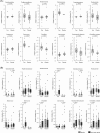Silk-derived sericin/fibroin mixture drink fermented with plant-derived Lactococcus lactis BM32-1 improves constipation and related microbiota: a randomized, double-blind, and placebo-controlled clinical trial
- PMID: 38966048
- PMCID: PMC11220338
- DOI: 10.12938/bmfh.2023-102
Silk-derived sericin/fibroin mixture drink fermented with plant-derived Lactococcus lactis BM32-1 improves constipation and related microbiota: a randomized, double-blind, and placebo-controlled clinical trial
Abstract
We previously showed through clinical trials that one plant-derived lactic acid bacteria (LAB) can improve constipation. We preliminarily found that the plant-derived LAB Lactococcus lactis BM32-1 can grow in a mixture of sericin and fibroin, which are extracted from silk and have been reported to help promote health. Thus, in the present study, we evaluated the favorable effect of a sericin/fibroin mixture (S/F-M), which was extracted from silk prepared from cocoons reared in an aseptic rearing system using an artificial diet, fermented with the BM32-1 strain through a clinical trial. The trial was conducted at Hiroshima University from June to October 2022 as a double-blind, placebo-controlled, randomized parallel-group comparative study with 50 eligible subjects (aged 23-71) who had an average defecation frequency of less than 5 times per week. The subjects were instructed to drink 100 mL of fermented S/F-M or placebo every day. After the 12 weeks of the clinical trial period, the average defecation frequency increased significantly-1.4 times higher than that at baseline in the test group-as compared with the placebo group. Furthermore, the fecal microbiota was also compared before and after treatment, revealing that intake of the fermented S/F-M significantly multiplied the relative abundance of the genera Enterococcus and Clostridium, which have been reported to contribute to the amelioration of constipation by improving the gut microbiota and producing butyric acid, respectively. In conclusion, the S/F-M fermented using the BM32-1 strain improves defecation frequency through alteration of the gut microbiota.
Keywords: clinical trial; constipation; fibroin; lactic acid bacteria; sericin.
©2024 BMFH Press.
Conflict of interest statement
None.
Figures


Similar articles
-
Effect of the consumption of a fermented dairy product containing Bifidobacterium lactis DN-173 010 on constipation in childhood: a multicentre randomised controlled trial (NTRTC: 1571).BMC Pediatr. 2009 Mar 18;9:22. doi: 10.1186/1471-2431-9-22. BMC Pediatr. 2009. PMID: 19296845 Free PMC article. Clinical Trial.
-
The effects of fermented milk containing Lactococcus lactis subsp. cremoris FC on defaecation in healthy young Japanese women: a double-blind, placebo-controlled study.Int J Food Sci Nutr. 2018 Sep;69(6):762-769. doi: 10.1080/09637486.2017.1417977. Epub 2018 Jan 16. Int J Food Sci Nutr. 2018. PMID: 29336182 Clinical Trial.
-
Effects of dietary fibers or probiotics on functional constipation symptoms and roles of gut microbiota: a double-blinded randomized placebo trial.Gut Microbes. 2023 Jan-Dec;15(1):2197837. doi: 10.1080/19490976.2023.2197837. Gut Microbes. 2023. PMID: 37078654 Free PMC article. Clinical Trial.
-
Sericin from Fibroin-Deficient Silkworms Served as a Promising Resource for Biomedicine.Polymers (Basel). 2023 Jul 4;15(13):2941. doi: 10.3390/polym15132941. Polymers (Basel). 2023. PMID: 37447586 Free PMC article. Review.
-
Interventions for preventing postpartum constipation.Cochrane Database Syst Rev. 2020 Aug 5;8(8):CD011625. doi: 10.1002/14651858.CD011625.pub3. Cochrane Database Syst Rev. 2020. PMID: 32761813 Free PMC article.
Cited by
-
Research progress on peptides that inhibit melanin synthesis.Front Pharmacol. 2025 Jul 2;16:1610623. doi: 10.3389/fphar.2025.1610623. eCollection 2025. Front Pharmacol. 2025. PMID: 40672371 Free PMC article. Review.
References
-
- Daimon T, Kiuchi T, Takasu Y. 2014. Recent progress in genome engineering techniques in the silkworm, Bombyx mori. Dev Growth Differ 56: 14–25. - PubMed
-
- Goldsmith MR, Shimada T, Abe H. 2005. The genetics and genomics of the silkworm, Bombyx mori. Annu Rev Entomol 50: 71–100. - PubMed
-
- Itoh K, Kobayashi I, Nishioka S, Sezutsu H, Machii H, Tamura T. 2016. Recent progress in development of transgenic silkworms overexpressing recombinant human proteins with therapeutic potential in silk glands. Drug Discov Ther 10: 34–39. - PubMed
-
- Tomita M, Munetsuna H, Sato T, Adachi T, Hino R, Hayashi M, Shimizu K, Nakamura N, Tamura T, Yoshizato K. 2003. Transgenic silkworms produce recombinant human type III procollagen in cocoons. Nat Biotechnol 21: 52–56. - PubMed
-
- Tomita M. 2011. Transgenic silkworms that weave recombinant proteins into silk cocoons. Biotechnol Lett 33: 645–654. - PubMed

